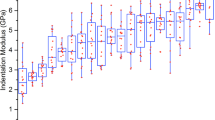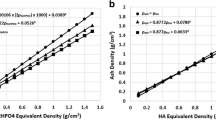Abstract
Introduction
While bone literature abounds with correlations of mechanical stiffness to mineralization, such correlations are reported without relating the findings to specific intracortical locations. This study reports on mapping of stiffness and mineralization distributions in ring-shaped cortical bone samples sliced from mid-diaphyseal bovine femur. Stiffness and mineralization measurements were conducted at points across the intracortical thickness along radial lines emanating from the inner (endosteal) surface to the outer (periosteal) surface. Measurements were taken along approximately 4 mm distance of cortical bone thickness.
Materials and methods
Three experimental techniques were employed: Vickers microhardness (HV), energy-dispersive X-ray (EDX) spectroscopy, and computed tomography (CT). Stiffness values were extracted from the Vickers microhardness tests. Elemental mineralization values (calcium %wt. and phosphorus %wt.) were determined from EDX data. All measurements were repeated on three different femur bones taken from different bovines (collected fresh from butcher).
Results
The study plots stiffness values and elemental mineralization (calcium %wt. and phosphorus %wt.) versus cortical thickness. Both stiffness and Ca %wt. and P %wt. are found to track and to linearly increase when plotted along the radial distance. The stiffness and mineralization trends collected from Vickers and EDX measurements were verified by employing the CT number (Hounsfield units, HU) via CT scans of the same bone samples. Data fitting via statistical methods revealed that all correlations were statistically significant.
Conclusion
Starting from endosteal to periosteal surfaces of mid-diaphyseal bovine femur, it was found that stiffness, mineralization, and HU values all exhibit increasing and correlating trends.







Similar content being viewed by others
References
Boivin G, Bala Y, Doublier A, Farlay D, Ste-Marie LG, Meunier PJ, Delmas PD (2008) The role of mineralization and organic matrix in the microhardness of bone tissue from controls and osteoporotic patients. Bone 43:532–538
Bala Y, Depalle B, Douillard T, Meille S, Clément P et al (2011) Respective roles of organic and mineral components of human cortical bone matrix in micromechanical behavior: an instrumented indentation study. J Mech Behav Biomed Mater 4:1473–1482
Haider IT, Lobos SM, Simonian N, Schnitzer TJ, Edwards WB (2018) Bone fragility after spinal cord injury: reductions in stiffness and bone mineral at the distal femur and proximal tibia as a function of time. Osteop Int 29:2703–2715
Cai X, Follet H, Peralta L, Gardegaront M, Farlay D et al (2019) Anisotropic elastic properties of human femoral cortical bone and relationships with composition and microstructure in elderly. Acta Biomater 90:254–266
Hage IS, Hamade RF (2017) Intracortical Stiffness of Mid-Diaphysis Femur Bovine Bone: Lacunar–canalicular Based Homogenization Numerical Solutions and Microhardness Measurements. J Mater. Sci Mater Med 28(9):135–147
Boskey AL, Posner AS (2018) Structure and formation of bone mineral. In: Hastings GW, Ducheyne P (eds) Natural and living biomaterials. CRC Press Boca Raton, Florida, pp 27–41
Bonfield W (2018) Elasticity and viscoelasticity of cortical bone. In: Hastings GW, Ducheyne P (eds) Natural and living biomaterials. CRC Press, Boca Raton, Florida, pp 43–60
Franco GL, Blank RD, Akhter MP (2011) Intrinsic material properties of cortical bone. J bone min meta 29:31–36
Boivin G, Meunier PJ (2002) The degree of mineralization of bone tissue measured by computerized quantitative contact microradiography. Calcif Tissue Int 70:503–511
Follet H, Boivin G, Rumelhart C, Meunier PJ (2004) The degree of mineralization is a determinant of bone strength: a study on human calcanei. Bone 34:783–789
Boivin GY, Chavassieux PM, Santora AC, Yates J, Meunier PJ (2000) Alendronate increases bone strength by increasing the mean degree of mineralization of bone tissue in osteoporotic women. Bone 27:687–694
Hansson T, Roos B, Nachemson ALF (1980) The bone mineral content and ultimate compressive strength of lumbar vertebrae. Spine (Phila. Pa. 1976) 5:46–55
Romanus B (1974) Physical properties and chemical content of canine femoral cortical bone in nutritional osteopenia: its reversibility and the effect of fluoride. Acta Orthop Scand Suppl 155:1–101
Zaichick V, Tzaphlidou M (2003) Calcium and phosphorus concentrations and the calcium/phosphorus ratio in trabecular bone from the femoral neck of healthy humans as determined by neutron activation analysis. Appl Radiat Isot 58:623–627
Tzaphlidou M, Speller R, Royle G, Griffiths J, Olivo A, Pani S, Longo R (2005) High resolution Ca/P maps of bone architecture in 3D synchrotron radiation microtomographic images. Appl Radiat Isot 62:569–575
Tzaphlidou M (2008) Bone architecture: collagen structure and calcium/phosphorus maps. J Bio Phys 34:39–49
Mandair GS, Morris MD (2015) Contributions of Raman spectroscopy to the understanding of bone strength. BoneKEy reports, p 4
Willems NMBK, Mulder L, den Toonder JMJ et al (2014) The correlation between mineralization degree and bone tissue stiffness in the porcine mandibular condyle. J Bone Miner Metab 32:29–37
Huang HL, Tsai MT, Lin DJ, Chien CS, Hsu JT (2010) A new method to evaluate the elastic modulus of cortical bone by using combined computed tomography and finite element approach. Biol Med 40:464–468
Yang G, Kabel J, VanRietbergen B, Odgaard A, Huiskes R, Cowin S (1999) The anisotropic Hooke’s law for cancellous bone and wood. J Elast 53:125–146
Rho JY, Hobatho MC, Ashman RB (1995) Relations of mechanical properties to density and CT numbers in human bone. Med Eng Phys 17:347–355
Cuppone M, Seedhom BB, Berry E, Ostell AE (2004) The longitudinal Young’s modulus of cortical bone in the midshaft of human femur and its correlation with CT scanning data. Calcif Tissue Int 74(3):302–309
Schneider R, Faust G, Hindenlang U, Helwig P (2009) Inhomogeneous, orthotropic material model for the cortical structure of long bones modelled on the basis of clinical CT or density data. Comp Meth Appl Mech Eng 198:2167–2174
Khan SN, Warkhedkar RM, Shyam AK (2014) Analysis of Hounsfield unit of human bones for strength evaluation. Proc mat sci 6:512–519
Eberle S, Göttlinger M, Augat P (2013) An investigation to determine if a single validated density-elasticity relationship can be used for subject specific finite element analyses of human long bones. Med Eng Phys 35:875–883
Gačnik F, Ren Z, Hren NI (2014) Modified bone density-dependent orthotropic material model of human mandibular bone. Med Eng Phys 36:1684–1692
Mimics student edition course book, Innovation Suite Research, Materialize Technologielaan 15–3001 Leuven-Belgium, http://www.materialise.com/en/medical/software/mimics, Accessed 10 Jan 2017
Yassine RA, Elham MK, Mustapha S, Hamade RF (2017) A detailed methodology for FEM analysis of long bones from CT using Mimics. In: ASME International Mechanical Engineering Congress and Exposition 2017 Nov 3 (Vol. 58363, p. V003T04A012). American Society of Mechanical Engineers.
Oliver WC, Pharr GM (2004) Measurement of hardness and elastic modulus by instrumented indentation: Advances in understanding and refinements to methodology. J Mat Res 19:3–20
Hage IS, Hamade RF (2015) Distribution of porosity in cortical (Bovine) Bone. In: Paper No. IMECE2015–51703, pp. V003T03A085; ASME 2015 International Mechanical Engineering specimen Congress and Exposition, Volume 3: Biomedical and Biotechnology Engineering specimen, Houston, Texas, USA, November 13–19, 2015.
Hage IS, Hamade RF (2016) Geometric-attributes-based segmentation of cortical bone slides using optimized neural networks. J Bone Miner Metab 34:251–265
Hage IS, Hamade RF (2018) Relating bone intra-cortical elastic stiffness to EDX spectroscopy mineralization measurements. In: Paper No. IMECE2018–86233; ASME 2018 International Mechanical Engineering Congress and Exposition, Volume 3: Biomedical and Biotechnology Engineering, Pittsburgh, USA, November 9–15, 2018
Luo C, Liao J, Zhu Z, Wang X, Lin X, Huang W (2019) Analysis of mechanical properties and mechanical anisotropy in canine bone tissues of various ages. BioMed Res Int 2019:3503152
Erickson GM, Catanese J III, Keaveny TM (2002) Evolution of the biomechanical material properties of the femur. Anat Rec 268:115–124
Langelier B, Wang X, Grandfield K (2016) Atomic scale chemical tomography of human bone. Sci Rep 7:1–9
Austman RL, Milner JS, Holdsworth DW, Dunning CE (2009) Development of a customized density—modulus relationship for use in subject-specific finite element models of the ulna. Proc Inst Mech Eng Part H J Eng Med 223:787–794
Wirtz DC, Schiffers N, Pandorf T, Radermacher K, Weichert D, Forst R (2000) Critical evaluation of known bone material properties to realize anisotropic FE-simulation of the proximal femur. J Biomech 33:1325–1330
Yassine RA, Hamade RF (2019) Transversely isotropic and isotropic material considerations in determining the mechanical response of geometrically accurate bovine tibia bone. Med Bio Eng Comp 57(10):2159–2178
Currey JD, Brear K, Zioupos P (1996) The effects of ageing and changes in mineral content in degrading the toughness of human femora. J Biomech 29:257–260
Acknowledgements
This work was made possible by the financial support of the Lebanese National Council for Scientific Research (CNRS) Award Number 103087. The authors also acknowledge the support of the University Research Boards (URB) of the American University of Beirut and the Notre Dame University-Louazie for their financial aid of this work.
Author information
Authors and Affiliations
Contributions
ISH, RSH, RAY and CYS contributed to research studies, analysis and writing. RFH supervised the work and contributed to reviewing and editing the work.
Corresponding author
Additional information
Publisher's Note
Springer Nature remains neutral with regard to jurisdictional claims in published maps and institutional affiliations.
About this article
Cite this article
Hage, I.S., Hage, R.S., Yassine, R.A. et al. Mapping cortical bone stiffness and mineralization from endosteal to periosteal surfaces of bovine mid-diaphyseal femur. J Bone Miner Metab 39, 725–736 (2021). https://doi.org/10.1007/s00774-021-01217-2
Received:
Accepted:
Published:
Issue Date:
DOI: https://doi.org/10.1007/s00774-021-01217-2




